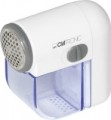Lid for blades
The lid prevents contamination of the working nozzle of the remover and its contact with foreign objects. This piece of equipment is useful for storage and transportation. Of course, with proper packaging, the remover can be stored/transported without a lid — however, such packaging is not always available, and the lid, in turn, often allows you to do without improvised packaging at all.
Brush for cleaning
The brush is convenient for cleaning the blades and other elements of the remover from waste that inevitably occurs during operation. Of course, other devices can also be used for this, but in general, complete brushes are considered the most convenient and practical option: they are quite effective, and the risk of damage to remover parts is minimal.
Power source
—
Mains. Operated through a standard 230 V socket, this type of power supply offers nearly unlimited runtime due to constant network voltage. The only breaks needed are to change processed items and allow the device to rest. However, the limitation lies in the inability to operate without sockets and the restricted mobility imposed by the power cord. Consequently, this power supply method is rarely used on its own and is typically combined with battery functionality.
—
Battery. Running on a standard, often built-in battery, this power source allows the remover's use without relying on nearby outlets. The absence of a network cable is an additional advantage. Although battery-powered devices are somewhat heavier and pricier than their network counterparts, the difference is minimal for lint removers and can't be considered a significant drawback. However, it's important to note that recharging the battery requires a power source, and the process is time-consuming once the charge is depleted. Additionally, battery-powered models are more costly than those with replaceable batteries. As a result, this option is relatively uncommon.
—
Batteries. Operating on standard replaceable batteries, typically AA, though alternative options may be available. These batteries enable autonomous device functioning, with the advantage of swiftly replacing a depleted batte
...ry with a fresh one. While battery-powered models are more affordable initially, they incur ongoing expenses as batteries need periodic replacement. Despite this cost, given the infrequent use of lint removers, it's not a significant concern, and the quick battery replacement feature proves beneficial. Additionally, rechargeable options are available, though they come at a higher upfront cost, eliminating the need for frequent battery purchases. For various reasons, batteries are considered the most convenient power source for lint removers.USB charging
The ability to charge the battery of the device
from the USB port. This function can be useful when traveling: if necessary, the battery of the device can be recharged from the Power bank or the USB port of the computer. The connector in the device itself comes in several varieties, in particular, microUSB and USB C.
Operating time
The operating time of the battery-powered lint remover (see above) on a single battery charge. It should be noted that this parameter is quite approximate, because the actual operating time is highly dependent on the intensity of the load on the operating nozzle. In addition, manufacturers can indicate the battery life of the machine in different ways: some provide data at an average load, others at idle. However, this information makes it possible to assess the battery life of the device.
For models powered by batteries, this parameter is not indicated: different brands of batteries vary greatly in performance, so the actual operating time is determined primarily by the quality of the replaceable parts.
Charging time
The time required to fully charge the battery (from zero to 100%) in properly powered lint removers (see above). This information allows you to estimate how long pauses in work will be required to charge the battery. (Although some models, supplemented by mains power, are able to work while charging).
Charge indicator
The presence of a
charge indicator in the design of a battery-powered lint removers (see above). Such an indicator is usually light, and the format of its operation may be different. So, in some models, it signals that the device has been successfully connected to a power source and the charging process is in progress, in others it reports the end of the process, in others, these features are combined (for example, the LED lights up during charging and goes out when it ends); may provide displaying the current charge level, etc. However, this feature simplifies the maintenance of a battery-powered remover, and it has almost no effect on the price anyway.

